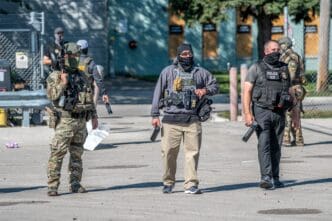Executive Summary
The Story So Far
Why This Matters
Who Thinks What?
A federal judge in Illinois has expressed “serious concerns” that federal law enforcement agents are not adhering to her order to avoid violent encounters with protesters and journalists in Chicago. U.S. District Court Judge Sara Ellis, an Obama appointee, announced new requirements for federal agents following reports and images suggesting violations of her previously issued temporary restraining order.
Judicial Scrutiny and New Requirements
During a short-notice hearing on Thursday, Judge Ellis stated she was “startled” and “not happy” by evidence indicating her order, issued last week, was not being followed. In response, she mandated that all federal agents equipped with body cameras must have them activated during interactions with immigration protesters.
Initially, Judge Ellis sought to require all agents to wear cameras. However, she agreed to some flexibility after Sean Skedzielewski, an attorney representing the Trump administration, argued that immediately equipping all agents would be logistically impossible. The Department of Justice maintained its opposition to the body camera order, citing the extensive resources required for recording, reviewing, and redacting video based on every allegation.
Allegations of Continued Violations
The temporary restraining order was initially issued after a coalition of local journalists and protesters sued the Trump administration. They alleged that federal law enforcement agents were targeting individuals engaged in peaceful activity, including multiple reporters who claimed they were subjected to pepper ball attacks despite identifying themselves as press.
Since the order was put in place, plaintiffs have identified at least two incidents where they believe agents failed to comply. One such confrontation occurred on Chicago’s southeast side on Tuesday, following a traffic accident involving U.S. Border Patrol agents.
Court Summons and Prohibitions
Judge Ellis has demanded that the field director of Operation Midway Blitz appear in court on Monday to provide an explanation for images and reports of tear gas being deployed without warnings. Her original restraining order specifically prohibits federal agents from targeting journalists who are not interfering with law enforcement and from using tear gas or less-lethal munitions on anyone who does not pose an “immediate threat to safety.”
The judge underscored the constitutional rights of protesters and journalists, stating, “You can’t shoot ‘em in the head (with pepper balls). You can’t deploy tear gas. You can’t use flash-bang grenades. You can’t drive a car through a crowd.” Earlier this month, a video depicting a pastor being repeatedly struck by pepper balls during a demonstration near an ICE facility in Chicago drew widespread criticism.
Administration’s Defense and Broader Context
Sean Skedzielewski suggested that the news coverage prompting the judge’s anger might be misleading, characterizing it as “one-sided and selectively edited media reports.” Judge Ellis acknowledged that some details in news reports might be disputed, which she cited as a reason for wanting to speak directly with the field director.
Illinois Governor JB Pritzker, who is not involved in the lawsuit, publicly stated his skepticism that Judge Ellis’s order was being followed, citing continued intense encounters. Governor Pritzker commented, “ICE is causing this mayhem. They’re the ones throwing tear gas when people are peacefully protesting.” In a separate but related development, another federal judge recently blocked President Trump from deploying National Guard troops in Chicago, an order the administration is currently appealing.








